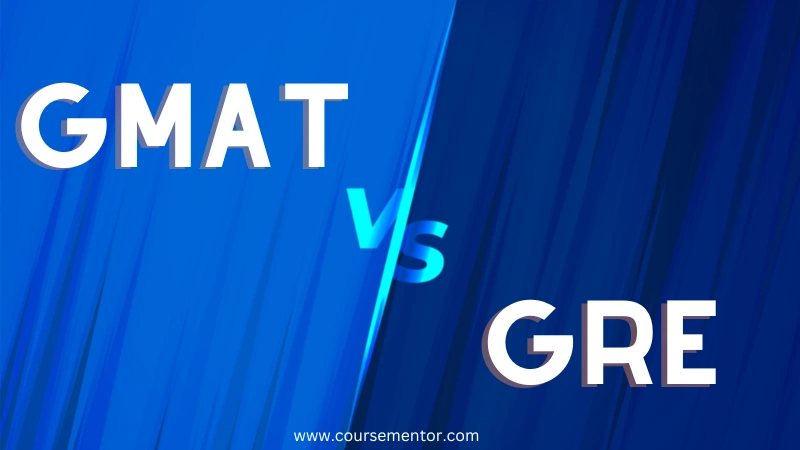The GMAT (Graduate Management Admission Test) and GRE (Graduate Record Examination) are standardized tests for admission to graduate programs, like MBA, Masters, or Ph.D. These exams test a candidate’s academic abilities and potential for success in graduate-level courses.
GMAT vs GRE, which exam must they choose to secure their admission to the graduate level courses? This is the first question that comes to students’ minds when they first decide to study abroad for graduate-level courses.
Both exams are accepted by all the major institutes worldwide. In this blog, we will cover every detail about both exams that will help you get answers to this question.
So let’s start by discussing both exams in brief.
What Is GMAT?
GMAT stands for “Graduate Management Admission Test.” It is a standardized test used to assess the skills of candidates interested in pursuing a graduate degree in business or management. The GMAT is required as part of the application process for graduate business programs, like an MBA.
The GMAT measures the test-taker’s abilities in various areas considered important to pursue in graduate-level business programs. The candidate’s skills are tested in areas like
- Analytical writing
- Integrated reasoning
- Quantitative reasoning
- Verbal reasoning
The test is computer-adaptive, which means that the difficulty level of the questions depends upon a candidate’s performance on previous questions. This allows the GMAT to measure candidates’ abilities accurately.
This exam is conducted by GMAC (Graduate Management Admission Council).
What Is GRE?
GRE stands for “Graduate Record Examination.” This test is also used to measure the student’s skills who want to pursue a graduate degree, but for fields like social sciences, natural sciences, humanities, and engineering. This exam is conducted by Educational Testing Service (ETS).
This exam measures students’ skills through three sections,
- Analytical writing
- Verbal reasoning
- Quantitative reasoning
If you want to know how long is GMAT score valid, then you can read our blog on it.
Pattern of the GMAT exam
The pattern of this exam depends upon the mode in which the student takes the exam. GMAT is a exam based on computer test. GMAT is a computerized test, in which the computer uses intelligence to carefully study the level of the student and then chooses the next question on the basis of student’s response to previous question.
For example, if a student answered the first question in a good way then the next question will be tough, and if the question was answered wrongly then the next question will be easy. This way this test is based on the student’s mental ability.
The GMAT exam makes up a total of 80 questions. All the questions are to be answered within a time length of 3 hours and 7 minutes. The GMAT exam is one of the most popular exams for students wanting to study in some of the topmost business schools in the world.
To score high in this competitive exam, students should know the pattern of the exam.
The GMAT exam contains four sections. The syllabus of the GMAT exam is quite broad. There is a variety of topics on which questions are asked. All the questions need to be completed in the given time frame.
GMAT integrated Reasoning section
The GMAT integrated reasoning section is based on data interpretation. The data can be from different sources in many formats. Carefully study all the data from different sources, Organize the data and check whether it is related or linked to some other, lastly students are needed to solve complex problems based on their understanding and analysis of the data for one or more sources.
The data can be in bar graphs, pie charts, Venn diagrams, etc. The key to scoring good marks in this section is to practice as many questions as possible while preparing for the GMAT exam.
GMAT Qualitative Section
The Qualitative Section of the GMAT exam is designed to test the student’s thinking and (related to careful studying or deep thinking) knowledge of basic math ideas. The basic math ideas include arithmetic, algebra and geometry.
The Qualitative section is further divided into two sections. The first is the Data interpretation questions and the second is the problem solving questions.
The GMAT Qualitative Section is of a time length of 62 minutes. The GMAT Qualitative Section consists of 31 questions. The main reason of this section is to check the student’s Math, algebra, and Geometry.
Students have 2 minutes for every question in the GMAT Qualitative Section. The time length of time of 62 minutes is to answer Qualitative questions in two formats: Problem Solving and Data interpretation.
The two types of questions are shuffled among each other, so the student doesn’t guess which category question will come next. Usually, according to the previous year question papers, there are 13-14 Data interpretation Questions and 17-18 Problem-Solving Questions.
GMAT Analytical Writing section
The GMAT Analytical Writing section is meant to test the critical thinking ability of the student. It contains questions in the form of an argument. The student needs to read and understand the argument and then write a conclusion on it.
The GMAT Analytical Writing section comprises of only 1 question. 30 minutes are provided to write a conclusion on the given argument. Students are advised to go through sample questions from reference book to write a good and scoring answer.
GMAT Verbal Thinking section
The main reason of the Verbal Thinking section of the GMAT exam is to test the student’s ability in reading and understanding written material, thinking and carefully studying arguments, and correcting writing for clearness in English Grammar.
The GMAT Verbal Thinking section is of 65 minutes in length of time. The GMAT Verbal Thinking section contains of 36 questions. That leaves students with about two questions per minute. An interesting aspect of this section is that six questions among the 36 questions are of the experimental type. That means that these six questions won’t be included in the final score.
However, these experimental questions are mixed with the other questions so that there is no way of recognizing which question will give you marks and which is experimental. Because of this, students are advised to treat all the questions with the same attention and dedication.
The GMAT Verbal Thinking section is adaptive, which means the score will also change throughout the exam based on the performance of the student instead of being scored at the end of the exam.
This is the main reason why students are left with unattended questions at the end of the exam because of time mismanagement.
Pattern Of GRE Exam
Quantitative Reasoning section of the GRE exam:
The quantitative reasoning section of the GRE exam tests the following abilities of students:
- basic skills of mathematics (upto 10th std)
- understanding of mathematical concepts upto 10th std syllabus
- quantitative reasoning ability and the skill to solve problems with quantitative methods.
Topics asked in quantitative section of the GRE exam
The questions in the Quantitative Reasoning section are of two types:
- Some are related to real-life situations.
- While others are purely mathematical.
Many of the QUESTIONS in the Quantitative sections are in the form of word problems that must be converted and modeled mathematically. The skills and concepts are examined in the four topic areas below:
- Arithmetic topics:
Properties and types of integers, for example divisibility, factorization, prime numbers, remainders and odd and even integers. Arithmetic operations, exponents and roots. Topics including estimation, percent, ratio, rate, absolute value, the number line, decimal representation and sequences of numbers.
- Algebra topics including:
Operations with exponents, factoring and simplifying complex algebraic expressions. Relations, functions, equations and inequalities. Solving linear and quadratic equations and inequalities. Solving simultaneous equations and inequalities. Setting up equations to solve word problems. Coordinate geometry, including graphs of functions, equations and inequalities, intercepts and slopes of lines.
- Geometry topics including:
Parallel and perpendicular lines. Circles, triangles, including isosceles, equilateral and 30°-60°-90° triangles. Quadrilateral and other polygons, Congruent and similar figures. 3-dimensional figures, area, perimeter, volume. The Pythagorean theorem, angle measurement in degrees
The ability to construct proofs is not tested in the qualitative section. The GRE quantitative section comprises of a total of 40 questions and 1hr 10 mins are given for this section.
The Analytical Writing section of the GRE exam
The analytical writing section is the first section of the GRE exam. It comprises of two arguments. 30-minutes are given for each question.
One question is to analyse an issue and the other question is to analyse the argument. Issue question asks students to understand the issue given in the question and to present their opinion on the issue.
The students are also required to give a possible solution for the issue. The Argument task presents an argument in the form of question and the students are required to evaluate the argument.
Students are required to analyse the argument and reach to conclusion rather than agreeing or disagreeing with the argument.
Both the questions of the Analytical Writing section are to test critical thinking abilities and to evaluate complex arguments and discussions.
The answers must be written by following the instructions. The Analytical Writing section consists of two different questions, but the score is calculated as a single combined number.
The combined score represents an average of the scores for each question.
Verbal Reasoning section of the GRE exam
Verbal reasoning section of the GRE exam is made to test students’ ability to understand written material, to fetch obtained materials, analyze connections among parts of a sentence, and understanding relationships between words and concepts.
The GRE exam tests fluency in English, and the Verbal Reasoning section is designed to test the ability to analyze language in different ways.
Verbal Reasoning comprises two sections of the five scores. The GRE is an adaptive form of exam, so the score of your second Verbal Reasoning section will depend on your performance in the first section.
The first section will be composed of a mixture of easy and difficult questions; the difficulty level of the second section is based on your performance. Test takers with good scores in first section will face more difficult questions in their second section.
The difficulty level of the second section is taken into account when the final score is calculated; more difficult tests have the chance to reach a higher final score.
The Verbal Reasoning sections of the GRE consists of three categories of question: Reading Comprehension, Text Completion, and Sentence Equivalence.
Half of questions are Reading Comprehension, and the other half are Text Completion and Sentence Equivalence.
The Verbal reasoning section consists of total 40 questions and 1hr is provided for the section.
GMAT vs GRE: Fee Structure
The fee is also an important factor while taking an exam and students mostly prefer to choose the exam that fits their budget. So here we will describe GMAT vs GRE fee structure.
GMAT Fee
The fee for the GMAT exam varies with the location you are taking the test and the type of test you are planning to take.
- The GMAT exam fee in India for the test type “Delivered at a Test Center” is US$275.
- The GMAT exam fee in India for the test type “Delivered Online” is US$300.
GRE Fee
The GRE exam fee also varies with the location of your test. In India, the GRE exam fee is $228.
Differences between the GMAT vs GRE
The key difference between GMAT Vs GRE exam is that the GMAT exam is specially for students aspiring to get an admission in business schools.
The GRE exam is not for a particular course. It makes the student eligible in many graduate programs, which also include various business and law programs.
The other difference between the GRE and the GMAT exam is of time duration. The GRE exam is of 3 hours and 45 minutes of time duration. While, the GMAT exam is of 3 hours and 7 minutes.
The GMAT comprises of the integrated reasoning section, while the GRE exam doesn’t have the integrated reasoning section. However, the other three sections are the same.
The GRE exam has more geometry related question, while the GMAT exam has more logical reasoning based questions.
The verbal section of the GRE exam is considered to be more difficult than the verbal section of the GMAT exam.
The GMAT exam fees in India is INR 21,000,while the GRE exam fees is INR 11,164. The GRE exam is less expensive.
Similarities between the GMAT VS GRE exam
- The GMAT VS GRE exams are both for admissions in graduate programs.
- Both the GMAT Vs GRE exams are recognized by several universities around the globe and both are universal exams.
- Both the GMAT VS GRE exams have three sections in common : Analytical writing section, quantitative section, and the Verbal reasoning section.
Which is best for students?
Both exams are more or less same, differing in just one key aspect. The main difference is the acceptance of GMAT exam is more in business schools, while the acceptance of the GRE exam is almost in all the graduate programs.
If a student is aspiring for business schools, then GMAT will be a better option. For all the students applying to different fields, the GRE exam will work the best.
Test takers find the GMAT exam a bit easier the GRE exam.
We encourage students to prepare for both the exams by following their respective syllabus.
Both the GMAT VS GRE exam follow the same pattern which means preparing for both simultaneously is a lot easier. We wish all the best to students in their future endeavors.
Conclusion (GMAT VS GRE)
In this blog, we have discussed the differences between GMAT vs GRE. We hope you have found the information you were looking for. If you have any other questions or concerns about GMAT vs GRE, please contact us anytime at CourseMentor™. Thank you for reading, we are always excited when one of our posts is able to provide useful information on a topic like this!
FAQs (GMAT VS GRE)
Does Harvard prefer GMAT or GRE?
Both exams are accepted by Harvard and if you submit multiple test scores the institute will prefer the exam you get a high score.
Do MBA programs accept GRE?
More than 1000 institutes worldwide accept the GRE exam for admission to different types of MBA courses.





